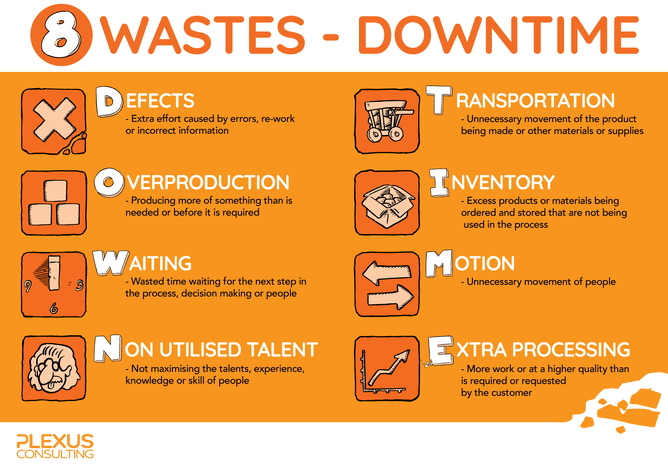It is mentioned in just about every blog post I write. It is the first thing a person will learn when discovering Lean, especially if they work with me. It is one of the key cornerstones of Lean thinking - so what the hell is ‘it’? Simply, ‘it’ are the 8 Wastes of Lean.
It is a simple way that people can learn to ‘see’ where waste is in a business, a process, when delivering a service or creating a product. But before we dig deeper into what these mystical wastes are, a quick history lesson.
Taiichi Ohno, considered the father of Toyota Production System, is credited to have created the original Lean framework. His approach was solely focused on the idea that teams can increase the value to the customer (through the product or service) with less work by eliminating the waste in the process. Anything that does not increase value in the eye of the customer is considered waste, or "Muda". As a result every effort should be made by everyone to eliminate that waste and that constant effort is what is called continuous improvement. It is all about lifting a team's productivity without working longer hours or increasing stress, in fact it is very much the opposite.
For some businesses, some of the specific wastes are more relevant than others, but they all exist across every process in every company. That is complex as Lean gets in its purest form. Encouraging everyone to question everything, asking why all the time so you can make each process just that little bit smoother, quicker, easier each day.
So let’s get into the Wastes and look at how it can apply in different types of work and different sectors. There are a number of ways and acronyms used by teams to remember all of the 8 Wastes. For me I use the acronym ‘DOWNTIME’ because it makes sense and has a clear connection to the goal of Lean - reducing downtime so we can add value to everything we do. The wastes also do not occur in isolation. In most cases issues or problems are a combination of these wastes, or one causes another e.g. errors and then the time fixing them may lead to others waiting for that particular product or service.
Defects
Eliminating rework because of errors and mistakes. It costs a business three times the value of the product or service for every error made. The productivity factor of three by itself should get the attention of every business owner. Measure the critical points of your process and the amount of errors and find out why they are occurring, then put a plan in place to improve it.
Overproduction
Making too much of a product or part. Or providing it earlier than required, so it is just sitting there creating cost for the business and not adding value. Ever wrote a report a few days before it was due? That is overproduction. While it might seem ok and harmless, this waste can actually tie up considerable cash for a business. So it is one we are always on the lookout for.
Waiting
I am often describing this as the silent killer of a business. It is easy to not see how much people can wait for something in a business. It might only be a few minutes or it could be weeks or even months. In most situations we have learned to accept waiting as part of business. For businesses who are serious about improving flow through the company, this is where I encourage you to put a lot of thought into. Get the workflow right and you can gain weeks of additional time for your business.
Non-utilisation of talent
Gallup has consistently found that organisations can improve productivity by up to 21% through better engaged staff. Think about this - 21% improvement in business performance without even looking at any process or systems improvement. By just engaging staff more effectively you can make a huge difference. That is using the talent you already have to its maximum potential. This is what ‘non-utilisation of talent’ is all about. How are you using the skills, passion, talents you already have in your business? Provide opportunities for people to up skill, challenge themselves in ways that are aligned with the company direction.
Transportation
The movement of product and supplies. This can be internally in your business, sub-components across the workshop or information flow virtually. If you want to see how crazy this can be, walk the process or the journey a document takes around your company and ask yourself is every step necessary? Why is the store room on the other side of the factory? Can there be sub-stores? Keep asking yourself and the team for better ways to manage this. Reduce the amount of distance items move around the business.
Inventory
This used to be an easy win for me to be honest and despite the challenges with the international supply chain and extended lead times, particularly for New Zealand, there are still opportunities to make some gains here. Blended with other wastes (they never exist perfectly in isolation) look at how inventory is reaching the point where it is adding value. Even if you have extra stock in the main stores, does the correct inventory reach the right place with just enough to do the job. How far is it moving throughout the workplace or facility? Do you have visual signals (kanban) when stock needs to be replenished, ordered etc. Don’t over-crowd the immediate work area with excess stock. So even if business continuity relies on ordering more inventory than you previously did before Covid, don’t let this be an excuse to relax on how you manage it.
Motion
The movement of people is still a major player in wasted time within an organisation. Time & motion studies can be an effective tool to review this. I have videoed workers and replayed it to the team so we can assess and ‘see’ the way they organise and move around the workplace. Sports teams do video analysis, why can’t we do this in business. The office environment is not immune to this as well. How often do we move around the office, go to the next building to seek the right information. What about gathering people to poorly planned meetings when it could have been an email. Extraneous movement of people can lead to significant lost time within a business.
Extra- processing
This waste is about producing more work or higher quality than is needed by the customer. Taking an Agile term - what is the minimum viable product the customer will be happy with? Everything else you deliver is waste. Internally this might be a 5 page report that can be reduced to a one pager with bullet point highlights. I once worked with a team of Insurance Brokers who realised they were all completing a form in which nearly half of the information collected was not even used! Wrapping product in a plastic bag only to put it in a box - is that step really necessary? It is ok to ask each other these types of questions, why do we actually do the process that way?
These are the eight wastes of Lean. they never exist alone, there is always a blend of 2-3 of these occurring in a process. By stepping back, observing and ‘seeing’ what is happening in a workplace with these wastes as a lens, teams can reduce the amount of additional work that is ultimately affecting the well-being of people and the profits of a business. It is ok to pause during the process and ask yourself or the team “are we experiencing waste here?”.
Taking the opportunity to make one percent changes everyday, chipping away at eliminating any actions we can that aren't adding value for the customer. That is how Lean uses the 8 wastes. Share the 8 wastes with your team, discuss them in a team meeting and challenge each other to spot one ‘waste’ per week and improve it - that is how simple it can be to start your Lean / Business Improvement journey.



